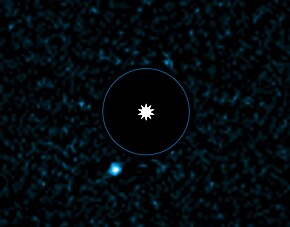HD 95086 b
 VLT image of the star HD 95086 and its planetary companion, seen here as a blue smudge. | |
| Discovery[1] | |
|---|---|
| Discovered by | Rameau et al. |
| Discovery site | Very Large Telescope |
| Discovery date | 2013 |
| Direct imaging | |
| Designations | |
| Levantes[2] | |
| Orbital characteristics | |
| 51-73 AU[3] | |
| Eccentricity | ≤ 0.18[3] |
| Inclination | 144+18 −4°[3] |
| 2004+105 −45 d[3] | |
| Star | HD 95086 |
| Physical characteristics | |
| Mass | 5.0 ± 2.0 MJ |
| 3.85 ± 0.5 m/s2 (12.6 ± 1.6 ft/s2) | |
Spectral type | L7–L9[4] |
HD 95086 b, formally named Levantes,
The host star was considered a highly probable member of the Lower Centaurus Crux star forming region,
Nomenclature
In August 2022, this planet and its host star were included among 20 systems to be named by the third NameExoWorlds project.[11] The approved names, proposed by a team from Greece, were announced in June 2023. HD 95086 b is named Levantes, from a modern Greek word referring to easterly Mediterranean winds, and its host star is named Aiolos after a Greek mythological figure.[2]
Discovery
The planet was initially detected in data taken in 2012 at a separation from the parent star of 623.9 ± 7.4
Spatially resolved images of the system from the Herschel Space Observatory[7] show evidence for a possible 2 belt system with a large clearing between the belts, similar to HR 8799. HD 95086 b is probably responsible for carving the sharp inner edge of the outer disk, but additional planets in this system occupying the rest of the gap may be a strong possibility.[5]
Physical properties
HD 95086 b is a massive planet that exists at a large orbital radius, therefore it is a viable candidate for a planet that formed close to its host star and was later scattered outwards via gravitational interactions with other massive particles in orbit around the star. In a debris disk, these particles are of the form of other orbiting planets or
The atmosphere of HD 95086 b contains large amounts of dust,[14] probably small, sub-micrometer forsterite grains.[4] The planet is very red in color, possibly due to the presence of the circumplanetary disk.[3]
References
- ^ S2CID 56062429.
- ^ a b c "2022 Approved Names". nameexoworlds.iau.org. IAU. Retrieved 7 June 2023.
- ^ S2CID 248874069.
- ^ arXiv:1801.05850
- ^ S2CID 28985252.)
{{cite journal}}: CS1 maint: multiple names: authors list (link - ^ Eric E. Mamajek. "Post-T Tauri Stars in the Nearest OB Association". Retrieved 2002-05-20.
- ^ S2CID 55592599.
- ^ P. T. De Zeeuw (1998-09-14). "A Hipparcos census of the nearby OB associations".
- ^ F. van Leeuwen. "Validation of the new Hipparcos reduction". Archived from the original on 2013-11-01. Retrieved 2007-08-08.
- ^ "List of ExoWorlds 2022". nameexoworlds.iau.org. IAU. 8 August 2022. Retrieved 27 August 2022.
- S2CID 59583242.
- .
- S2CID 55041736



